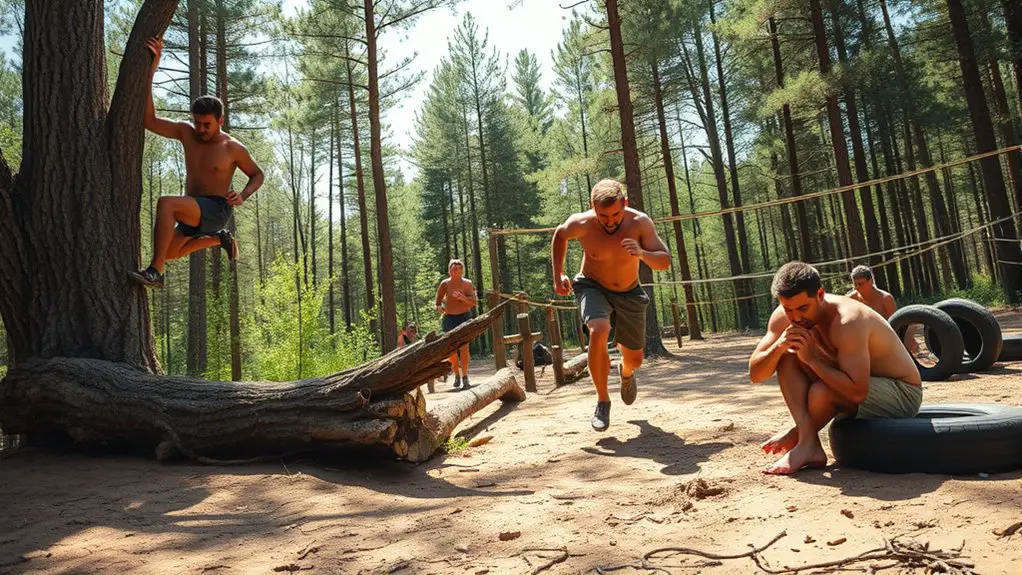To prepare for life's toughest challenges, focus on functional fitness that enhances your strength, balance, and coordination. Build endurance through cardio exercises like running and swimming, and incorporate outdoor workouts to harness nature's elements. Add strength and agility drills to boost your resilience, and engage in group training for community support. Don't forget the importance of nutrition and hydration to optimize your performance. There's so much more to this approach that'll help you thrive in any situation!
The Importance of Functional Fitness
When it comes to survival, functional fitness plays an essential role in preparing you for real-life challenges. Unlike traditional workouts that focus solely on aesthetics, functional fitness trains your body for movement patterns you encounter daily. You're not just lifting weights; you're building strength, balance, and coordination that'll keep you agile in tough situations.
Imagine needing to climb a fence, carry a heavy load, or sprint away from danger. These aren't just exercises—they're crucial skills for freedom. By engaging in functional movements like squats, lunges, and push-ups, you enhance your body's resilience. This type of training emphasizes core stability and strength, ensuring you can perform effectively under pressure.
Moreover, this type of training improves your overall mobility, allowing you to navigate diverse terrains with ease. So, whether you're hiking through the wilderness or simply handling everyday tasks, functional fitness equips you to thrive in any environment. Embrace it, and you'll find yourself more prepared for whatever life throws your way.
Building Endurance for Survival Situations
Building endurance is essential for surviving tough situations, and it starts with effective cardio conditioning exercises. Incorporating interval training techniques can help you boost your stamina quickly, while outdoor endurance activities get you accustomed to real-world challenges. Interval training not only enhances your endurance but also increases metabolism, making it a highly effective method for preparing you for anything life throws your way.
Cardio Conditioning Exercises
Effective cardio conditioning exercises are essential for enhancing your endurance in survival situations. You'll want to build stamina to keep moving when it counts. Here are four exercises that can help you achieve that:
- Running or Jogging: This classic exercise boosts your cardiovascular health and builds leg strength.
- Cycling: Whether outdoors or on a stationary bike, cycling improves leg endurance and lung capacity.
- Swimming: A full-body workout that's easy on the joints, swimming enhances stamina while providing resistance.
- Jump Rope: This simple yet effective technique increases heart rate and coordination, making it a great addition to your routine.
Incorporate these exercises into your training, and you'll be better prepared for any survival scenario that comes your way.
Interval Training Techniques
While traditional cardio workouts are important, incorporating interval training techniques can greatly enhance your endurance for survival situations. This method involves alternating between high-intensity bursts and periods of low-intensity recovery. For example, sprint for 30 seconds, then walk for one minute. This not only boosts your cardiovascular fitness but also improves your body's ability to recover quickly—a crucial skill when you're in a survival scenario.
You can customize your intervals based on your fitness level, making it accessible and adaptable. Whether you're running, cycling, or even doing bodyweight exercises, the key is to push your limits. Embrace this freedom in your training, and you'll build the stamina needed to face any challenge that comes your way.
Outdoor Endurance Activities
After incorporating interval training techniques, it's time to take your endurance to the next level with outdoor activities. Nature's your playground, and these activities will boost your stamina for survival situations:
- Hiking: Explore varied terrains; it challenges your body while connecting you with the wild.
- Trail Running: Push your limits on uneven paths; it sharpens your agility and endurance.
- Cycling: Hit the trails or backroads; cycling builds leg strength while giving you freedom to roam.
- Swimming: Find a lake or river; it's a full-body workout that enhances lung capacity and resilience.
These outdoor endurance activities not only strengthen your body but also invigorate your spirit, preparing you for any challenge life throws your way.
Outdoor Training: Harnessing Nature's Gym
When you step outside, nature offers a unique gym filled with challenges. From climbing over fallen logs to using rocks for weight training, you can turn everyday obstacles into effective workouts. Plus, eco-friendly exercises not only boost your fitness but also connect you with the environment.
Utilizing Natural Obstacles
Nature offers an incredible array of obstacles that can transform your workout into an adventurous and effective training session. By utilizing what's around you, you can enhance your fitness while embracing the freedom of the outdoors. Here are four natural obstacles you can incorporate into your training:
- Logs: Use fallen trees for balance beams or to perform step-ups.
- Hills: Sprinting or hiking up inclines builds endurance and strength.
- Rivers or Streams: Engage in agility drills by jumping across stones or maneuvering through shallow waters.
- Boulders: Climbing over rocks challenges your upper body and core strength.
Embrace these elements, and you'll not only elevate your fitness routine but also deepen your connection with the wild around you.
Eco-Friendly Workouts
Have you ever thought about how your workout routine could benefit both your body and the environment? Eco-friendly workouts let you tap into nature's gym. Running on trails, doing push-ups against trees, or practicing yoga in a park not only gets your heart pumping but also connects you with the world around you.
Here's how your outdoor workouts can inspire change:
| Activity | Environmental Impact | Personal Benefit |
|---|---|---|
| Trail Running | Preserves natural habitats | Boosts cardiovascular health |
| Tree Push-Ups | Reduces plastic use | Builds upper body strength |
| Park Yoga | Promotes green spaces | Enhances flexibility and calm |
| Outdoor Cycling | Lowers carbon footprint | Strengthens leg muscles |
| Nature Hikes | Encourages conservation | Improves mental clarity |
Strength Training for Survival Scenarios
While most people associate strength training with aesthetics or athletic performance, it's essential for survival scenarios, too. Building functional strength enables you to tackle unexpected challenges and enhances your independence. Here are four significant benefits of strength training for survival:Strength training goes beyond aesthetics; it equips you for survival, fostering independence and resilience in unexpected challenges.
- Improved Resilience: Stronger muscles help you endure physical stress, whether you're lifting heavy objects or maneuvering through difficult terrain.
- Increased Endurance: Strength training enhances your overall stamina, allowing you to last longer during physically demanding situations.
- Enhanced Self-Defense: Physical strength can empower you to protect yourself or others in dangerous situations.
- Better Recovery: Strong muscles and joints support your body's ability to heal and recover from injuries, keeping you agile when it counts.
Incorporating regular strength workouts into your routine can grant you the freedom and confidence to face whatever comes your way. After all, survival is about being prepared and self-sufficient. Additionally, engaging in exercises like squats and deadlifts can significantly enhance your overall strength and power, making you better equipped for survival challenges.
Agility and Coordination Drills
When you're in a survival situation, agility and coordination can make all the difference. Ladder drills can enhance your footwork, while cone drills improve your ability to change direction quickly. Let's explore how these techniques can boost your overall performance. Consistent practice of agility ladder drills can lead to significant improvements in your athletic performance.
Ladder Drills Benefits
Although ladder drills might seem simple at first glance, their benefits for agility and coordination are profound. Engaging in these drills can transform your fitness journey by enhancing your movement and freedom. Here are some key benefits:
- Improved Footwork: You'll develop quick and precise foot movements, essential for any survival scenario.
- Enhanced Balance: These drills challenge your stability, helping you maintain control in unpredictable situations.
- Increased Speed: Ladder drills boost your overall speed, allowing you to react faster when it matters most.
- Boosted Coordination: You'll refine your hand-eye coordination, essential for multi-tasking in high-pressure environments.
Incorporating ladder drills into your routine empowers you, giving you the agility to navigate life's challenges with confidence.
Cone Drills Techniques
Building on the agility gains from ladder drills, cone drills take your training a step further by challenging your ability to change direction quickly and efficiently. Set up a series of cones in various patterns—like T-shapes or zigzags—and practice sprinting, shuffling, or backpedaling between them. Focus on explosive starts and sharp turns, feeling the freedom of fluid movement. As you become more comfortable, increase your speed or add complexity to the patterns. This'll not only enhance your coordination but also improve your balance and reaction time. Remember, it's all about mastering those swift shifts. With regular practice, you'll develop the agility needed for any survival scenario, empowering you to navigate your environment with confidence and ease.
Incorporating Survival Skills Into Workouts
Incorporating survival skills into your workouts not only enhances physical fitness but also prepares you for unexpected situations. By blending these skills with your training, you're building strength, agility, and mental toughness. Here are four ways to integrate survival skills into your fitness routine:
- Obstacle Course Training: Create a makeshift course to practice climbing, crawling, and traversing tough terrain, simulating real-world challenges.
- Weight Carrying: Incorporate functional movements by carrying heavy objects over distances, mimicking the need to transport gear or supplies.
- Self-Defense Techniques: Add martial arts drills to boost your confidence and awareness in unpredictable environments.
- Navigation Drills: Use a map and compass during outdoor runs, sharpening your orientation skills while improving cardiovascular health.
Cardio Training for Emergency Preparedness
While honing survival skills is essential, having a solid cardio foundation is equally important for emergency preparedness. You never know when you might need to sprint away from danger or endure a long trek to safety. Cardio training boosts your endurance, ensuring you can keep moving when it counts.
Incorporate activities like running, cycling, or swimming into your routine. Interval training can be especially effective, as it mimics the stop-and-go nature of emergencies. Aim for at least 150 minutes of moderate-intensity cardio each week, and mix in high-intensity sessions to build your stamina. Additionally, understanding training zones helps you tailor your cardio workouts for maximum effectiveness.
Don't forget to include functional movements, like stair climbing or hill sprints, that reflect real-life scenarios. The goal is to prepare your body for anything that comes your way. By prioritizing your cardio fitness, you empower yourself with the freedom to escape, adapt, and thrive when faced with unexpected challenges.
Group Training: Building Community Resilience
When you train in a group, not only do you enhance your physical abilities, but you also foster a sense of community that can be crucial during emergencies. The bonds you create can lead to resilience and strength in challenging times. Here are some reasons why group training is essential:
Training in a group not only boosts your fitness but also builds a supportive community vital in challenging times.
- Shared Goals: Working together towards common fitness and survival objectives builds unity and accountability.
- Skill Exchange: Each member brings unique skills, allowing you to learn important techniques from one another.
- Motivation Boost: You'll push each other to perform better and stay committed, especially when the going gets tough.
- Emotional Support: In high-stress situations, having a supportive network can make all the difference, reducing fear and anxiety.
Additionally, group training can enhance preparation and practice, as consistent practice together fosters confidence and allows everyone to learn and grow collectively. Embrace group training as a way to not only elevate your fitness but also to strengthen the community around you. Together, you're more resilient!
Mental Conditioning for High-Stress Situations
Training in a group not only builds physical strength but also lays the groundwork for mental resilience, which is essential in high-stress situations. Engaging in collective exercises helps you learn to push through discomfort together, fostering a shared sense of purpose and determination. To enhance your mental conditioning, consider these strategies:
| Technique | Purpose |
|---|---|
| Visualization | Picture yourself succeeding in crises |
| Breathing Exercises | Regain control and reduce anxiety |
| Positive Affirmations | Reinforce self-belief and focus |
| Stress Exposure Drills | Simulate high-pressure scenarios |
Incorporating mindfulness meditation into your routine can further empower you to embrace the here and now during challenging moments.
Nutrition and Hydration for Optimal Performance
How can the right nutrition and hydration impact your performance during survival fitness training? Properly fueling your body can be the difference between thriving and merely surviving. When you're out there pushing your limits, you need every advantage.
Here are four essential elements to take into account:
- Macronutrient Balance: Make sure you're eating the right mix of carbs, proteins, and fats to sustain your energy levels and repair muscles.
- Hydration: Staying hydrated keeps your mind sharp and your body functioning at its best. Dehydration can lead to fatigue and decreased performance; monitoring urine color can help you assess your hydration status.
- Timing: Fueling up before and refueling after workouts helps maximize your efforts and recovery.
- Quality Over Quantity: Opt for whole, nutrient-dense foods that give you sustained energy rather than quick fixes that leave you crashing.
Embrace the freedom of ideal nutrition and hydration to elevate your survival fitness training!
Frequently Asked Questions
What Are the Best Supplements for Survival Fitness Training?
For survival fitness training, you'll want supplements like protein powder for muscle recovery, electrolytes for hydration, and omega-3s for inflammation. These can help you perform better and stay strong when you need it most.
How Often Should I Train for Optimal Survival Preparedness?
To achieve ideal survival preparedness, you should train at least three to four times a week. Focus on a mix of strength, endurance, and agility workouts to guarantee you're ready for any situation life throws your way.
Can I Train for Survival Fitness at Home?
Absolutely, you can train for survival fitness at home! With bodyweight exercises, agility drills, and functional movements, you'll build strength and endurance. Just stay consistent, and you'll be ready for anything that comes your way.
What Equipment Do I Need for Outdoor Survival Training?
For outdoor survival training, you'll need versatile gear like a sturdy shelter, supportive shoes, survival tools, and hydration systems. Each essential element empowers your exploration, enhancing freedom and flexibility in forging your path through nature.
How Do I Track My Progress in Survival Fitness?
To track your progress in survival fitness, keep a journal of workouts, note improvements in strength and endurance, and set specific goals. Regularly reviewing your progress helps you stay motivated and focused on achieving freedom.




